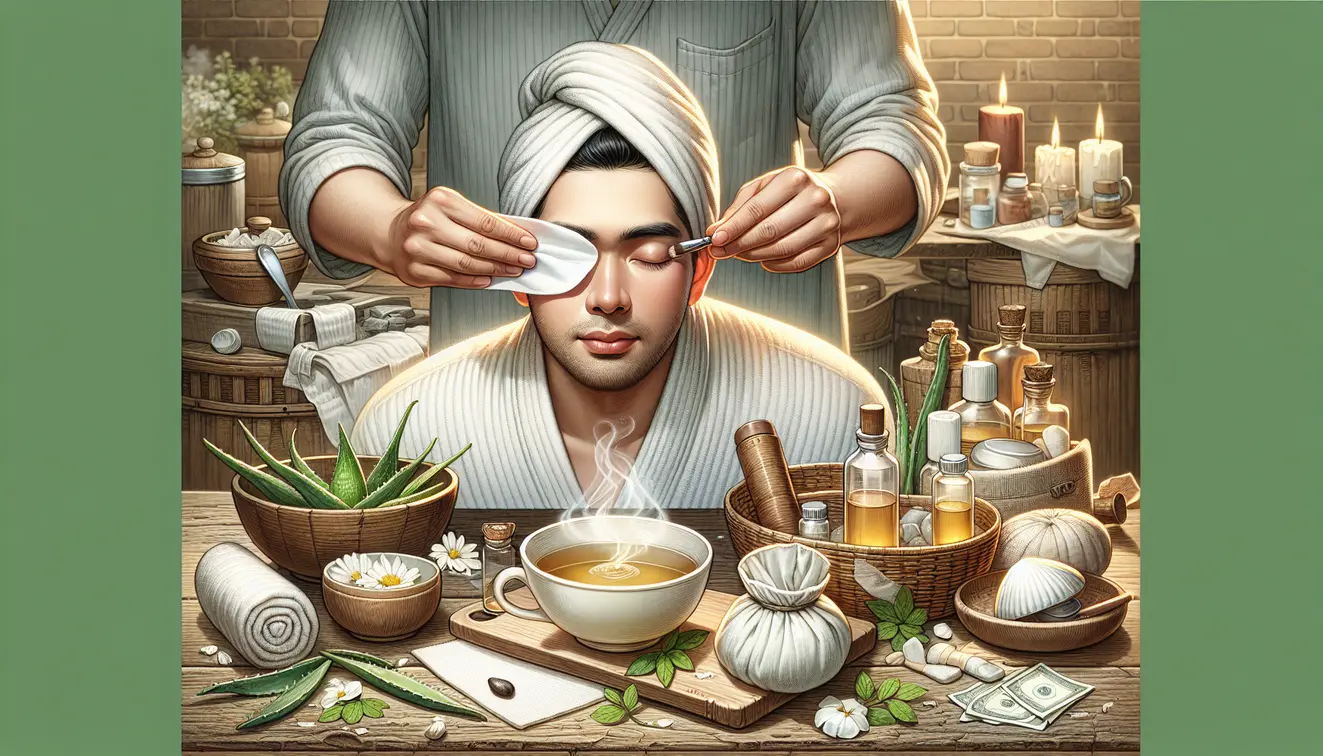Home Remedies for Eye Styes: Your Comprehensive Guide to Natural Relief
Estimated reading time: 8 minutes
Key Takeaways
- Eye styes are painful lumps on the eyelid often caused by bacterial infections.
- Home remedies like warm compresses and tea bags can provide natural relief.
- Hygiene is critical—always use clean tools and avoid popping a stye.
- Seek medical help if a stye persists beyond a week or affects vision.
- Prevention involves daily habits like handwashing and proper makeup removal.
Table of Contents
- Introduction to Eye Styes: What You Need to Know
- What Causes Eye Styes? Understanding Triggers and Risk Factors
- Top 8 Home Remedies for Eye Styes: Safe and Effective Solutions
- Safety First: Precautions When Using Home Remedies
- When to Seek Medical Help: Know the Red Flags
- Preventing Eye Styes: Daily Habits for Eye Health
- Quick Answers: Common Questions About Eye Styes
- Tools for Eye Care: Supporting Your Home Remedy Routine
Introduction to Eye Styes: What You Need to Know
Welcome to WikiHomeRemedies, where we guide you through nature’s healing paths with care and expertise. If you’ve ever woken up to a tender, red lump on your eyelid, you know the discomfort of an eye stye. These bothersome bumps can disrupt your day, but relief doesn’t always require a trip to the doctor. In this guide, we’ll walk you through what eye styes are, why they happen, and how to ease them with safe, natural solutions. Backed by insights from trusted sources like Mayo Clinic, we’re here to help you find comfort right at home while knowing when professional care is needed. Let’s dive in and soothe that irritation together.
An eye stye is a small, painful lump that forms on or near your eyelid. It often stems from a bacterial infection, usually in the oil glands or hair follicles along the lash line. While they can sting and look unpleasant, styes are quite common and affect people across all ages. What makes them pop up? Simple things like touching your eyes with unwashed hands or stress can play a role. For mild cases, home remedies offer a gentle, accessible way to find relief. At WikiHomeRemedies, we understand how unsettling this discomfort can be, and we’re here to share natural solutions that work. For more insights on related eye conditions, check out our detailed guide on eye infections.
What Causes Eye Styes? Understanding Triggers and Risk Factors
Eye styes often start with a bacterial infection, most commonly from Staphylococcus, which thrives when oil glands near the eyelid get blocked. Poor hygiene, like forgetting to wash your hands before rubbing your eyes, can invite trouble. Even expired makeup or a dirty pillowcase can contribute to this irritation, as highlighted by insights from WebMD and NIH.
Several factors raise the odds of developing a stye. Stress, lack of sleep, or hormonal shifts can weaken your body’s defenses, making it easier for infections to settle in. Touching your eyes often or using contact lenses without proper cleaning also heightens the risk. Some folks, especially those with conditions like blepharitis, may face recurring issues. Understanding these triggers helps explain why styes form and points us toward prevention. Let’s look at who might be more prone to them:
- Contact lens wearers who skip proper hygiene.
- People who rub their eyes frequently with unclean hands.
- Those dealing with chronic eyelid inflammation or stress.
Knowing the root of the problem sets the stage for effective care. Now, let’s move to natural ways to tackle this discomfort.
Top 8 Home Remedies for Eye Styes: Safe and Effective Solutions
When a stye strikes, relief is likely at your fingertips with items already in your home. Below, we’ve gathered eight trusted remedies to help reduce pain and swelling naturally. Each method comes with clear steps and safety tips to ensure you’re caring for your eyes with confidence. Backed by scientific reasoning and widespread recommendations from places like Mayo Clinic, these solutions aim to soothe while respecting the delicate eye area. Let’s explore how to ease that tenderness, starting with a classic approach.
Warm Compress: The Go-To Remedy for Drainage
A warm compress stands as a top choice for stye relief. Soak a clean cloth in warm water, around 100–110°F (38–43°C), and gently place it over your closed eye for 10 to 15 minutes. Repeat this three to four times a day. The heat increases blood flow, helping the stye drain naturally. Be mindful to keep the water from being too hot, and always use a fresh cloth for each session to avoid spreading bacteria.
Tea Bag Compress: Harnessing Tannins for Relief
Tea bags, especially black or green, carry tannins that fight inflammation and bacteria. Steep a tea bag in hot water, let it cool until it’s just warm, then rest it on your closed eye for 5 to 10 minutes. This simple trick can calm the swelling. Make sure the bag is clean and not too hot to prevent any irritation or burns near the sensitive skin of your eyelid.
Gentle Eyelid Cleansing with Baby Shampoo
Cleaning your eyelid can clear away debris and bacteria causing the stye. Mix a small amount of mild baby shampoo with warm water, then dip a cotton swab into the solution. Gently wipe along your lash line with care. This helps keep the area free of buildup. Stop immediately if you feel any sting, and keep the solution out of your eyes to avoid discomfort.
Aloe Vera Gel: Natural Soothing Power
Aloe vera brings a cooling touch with its anti-inflammatory and antibacterial traits. Dab pure aloe vera gel around the stye, not inside the eye, using clean fingers. This can ease the redness and soreness. Test it on a small patch of skin first to rule out allergies, and ensure it stays away from direct eye contact for safety.
Turmeric Paste: Anti-Inflammatory Support
Turmeric, with its active compound curcumin, offers a natural way to curb inflammation. Mix a pinch of turmeric powder with water to form a paste, then apply it near the stye using a clean swab. Rinse it off after 10 minutes. This can help with swelling and infection. Do a patch test beforehand to check for skin sensitivity, and avoid letting it touch the eye itself.
Coriander Seed Wash: A Gentle Antiseptic Rinse
Coriander seeds hold antiseptic properties that may aid in calming a stye. Boil a teaspoon of seeds in a cup of water, let it cool completely, then strain the liquid. Use it to rinse your eyelid gently. This wash can support cleanliness around the affected area. Always ensure the solution is at room temperature, and stop if you notice any irritation during use.
Potato Poultice: Drawing Out Inflammation
A raw potato might sound unusual, but it can help pull out swelling. Grate a small piece, wrap it in a clean cloth, and lay it over your closed eye for 5 to 10 minutes. Some find this reduces puffiness around the stye. Keep your tools clean to prevent added bacteria, and discontinue if you see no improvement after a couple of tries.
Chamomile Rinse or Compress: Calming Comfort
Chamomile is known for its calming effects and can ease eyelid irritation. Brew a cup of chamomile tea, let it cool, then use the liquid as a rinse or soak a clean cloth for a compress. Apply it gently for a few minutes. This offers a soothing touch to tender skin. Check for allergies first, and maintain strict hygiene with any materials you use.
These remedies provide a range of options to suit what you have on hand. With consistent care and cleanliness, relief often comes within a few days. Next, let’s talk about keeping safety at the forefront while using these methods.
Safety First: Precautions When Using Home Remedies
Treating a stye at home can be effective, but the eye area demands extra caution. Hygiene is your first defense—always wash your hands before and after touching near your eyes. Use only clean cloths, swabs, or tools, and never share towels or makeup with others, as bacteria can spread easily.
There are key actions to avoid as well. Never try to pop or squeeze a stye, as this can worsen the infection or cause scarring. Steer clear of unsterilized items or untested mixtures near such a sensitive spot. Be watchful for signs of trouble, like increased pain or unexpected reactions, which might signal an allergy or complication. Resources from the American Academy of Ophthalmology echo this caution, urging care over haste. Prioritizing safety ensures these natural approaches help rather than harm. If something feels off, it might be time to look beyond home care, which we’ll cover next.
Here are a few risks to keep in mind:
- Allergic reactions to herbs or ingredients like turmeric or aloe.
- Worsening symptoms, such as growing redness or swelling.
- Irritation from improper application, especially with rinses or pastes.
When to Seek Medical Help: Know the Red Flags
Home remedies often soothe a stye, but some situations call for a doctor’s insight. If your stye lingers beyond a week, grows larger, or starts to blur your vision, don’t wait to get help. Severe pain or swelling that spreads beyond the eyelid also signals a need for professional care. Advice from trusted places like Cleveland Clinic underlines the importance of acting promptly in these cases.
Recurring styes might hint at deeper issues, such as blepharitis or immune system concerns. Medical options, when needed, could include antibiotics to fight stubborn infections, steroid injections for inflammation, or even minor drainage procedures for severe cases. Watching for these warning signs ensures you’re not overlooking something serious:
- A stye that persists or worsens after seven days of home care.
- Any impact on vision, like blurriness or difficulty focusing.
- Intense discomfort or a stye that rapidly increases in size.
Knowing when to step beyond natural remedies keeps your eye health in check. Let’s now focus on stopping styes before they start with daily habits. If you’re also dealing with itchy eyes, learn more about natural solutions for that condition at itching eyes.
Preventing Eye Styes: Daily Habits for Eye Health
Keeping styes at bay often comes down to small, mindful routines. Start with cleanliness—wash your hands before touching your face or eyes to avoid transferring bacteria. Make it a habit to remove makeup every night and keep your eyelids free of buildup, a tip supported by general health guidance from NIH.
Your lifestyle matters too. Avoid sharing towels, pillowcases, or eye products, as these can carry germs. Replace old makeup every few months, and always sanitize contact lenses properly. Nourishing your body helps as well—drink plenty of water, manage stress through rest or relaxation, and eat foods rich in Vitamin A, like carrots or spinach, to support skin and eye wellness. These steps empower you to reduce the chances of a stye returning:
- Cleanse eyelids regularly with a gentle, safe solution.
- Toss out expired cosmetics and disinfect lens cases often.
- Prioritize sleep and hydration for overall skin health.
Building these practices into your day can make a real difference. Let’s wrap up with quick answers to common queries about styes for added clarity. For related eye concerns like pinkeye, explore additional remedies in our dedicated article at pinkeye remedies.
Quick Answers: Common Questions About Eye Styes
Eye styes bring up plenty of questions, and we’re here to clear the air with straightforward answers. These cover the basics many wonder about while keeping things brief for easy scanning.
- Are styes contagious? Generally, no, but the bacteria causing them can spread through shared items like towels or makeup brushes, so keep personal items separate.
- What is a stye exactly? It’s a painful lump on the eyelid, often from a bacterial infection clogging an oil gland or follicle near the lash line.
- Which home remedies are best for inflammation? Warm compresses, chamomile rinses, and aloe vera stand out for calming puffiness and redness naturally.
- How do warm compresses compare to tea bag compresses? Warm compresses focus on boosting drainage through heat, while tea bags add antibacterial tannins for extra infection-fighting support.
These snippets aim to address lingering doubts with ease. Now, let’s look at a few tools that can support your care routine.
Tools for Eye Care: Supporting Your Home Remedy Routine
Beyond natural remedies, a few handy items can streamline your efforts to manage styes or maintain eye hygiene. Think of these as optional companions to the solutions we’ve discussed, fitting into steps like cleansing or applying compresses. The focus stays on their practical use rather than pushing a purchase.
Consider items like hypoallergenic eyelid wipes, often relied upon for gentle cleaning around sensitive areas. They pair well with routines to keep lashes free of debris. Small, clean cloths or sterile cotton pads also work wonders for preparing compresses or safely dabbing on remedies like aloe vera. Even a dedicated lens cleaning kit, if you wear contacts, supports prevention by reducing bacterial buildup. Widely used options in these categories often come with user trust for eye care needs. Adding such tools can simplify staying consistent with hygiene and natural treatments, rounding out your path to relief.










